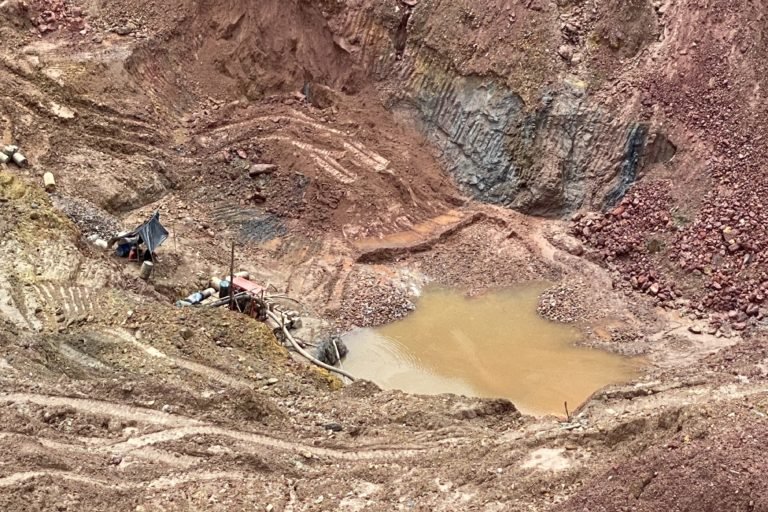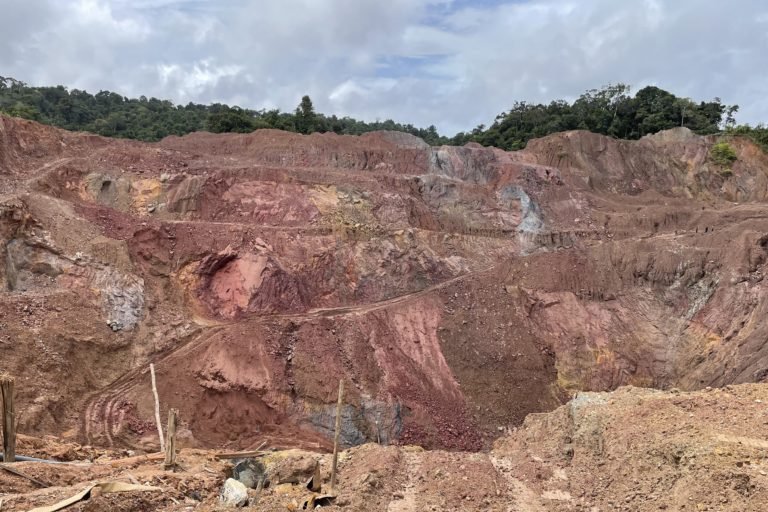- Medium-scale mining operations occurring in a tiny riverine community in northwest Guyana has led to deforestation and discoloration in vital waterways after tailing ponds spilled into creeks and a river.
- The conflict between locals and miners began after the Guyanese mining body issued mining permits on land that was already titled to the Carib Indigenous community – without consulting the village council. After trying to walk back on these issued permits, the Caribbean Court of Justice (CCJ) dismissed the case.
- The CCJ and subsequent rulings are being used to prevent locals from traversing on their titled lands. Community members are not able to receive royalties and mine at the site, a practice they have sustainably done for generations.
- Vickram Bharrat, the country’s Minister of Natural Resources, says that the government must comply with the CCJ ruling but intends to investigate threats to the lives of community members as they attempt to find a workable solution.
CHINESE LANDING, Guyana – When first entering the territory of the Carib Indigenous community in Chinese Landing, northwest Guyana, there are no signs of environmental destruction. At first glance, it can even be said that the tiny riverine community is thriving. But this is hardly the case.
Further into the center of the community’s titled lands, a medium-scale gold mining operation driven by people across the country and Venezuela to the north has left over 2 hectares (about 5 acres) of land deforested and discolored waterways. In the last year, lands have been severely degraded and sections of the forest containing commercial species of trees locals typical sell for income, such as the Purple Heart Tree (Peltogyne spp.), have been cut down to make way for gold mining activities and the construction of mining camps. Chinese Landing is generally forested with small patches of savannahs lands in between.
Mining for gold is not unusual in Chinese Landing. In fact, according to Orin Fernandes, the toshao or chief of the community, artisanal mining can be described as part of their culture. It was a practice that first began with their ancestors centuries ago when there was need for tools and continues today. The gold from mining activities would be traded for items that were needed in the community.
While mining occurred on their ancestral lands for generations, there was minimal impact on the environment.
“The forest was our hospitals and supermarkets,” Fernandes told Mongabay. He explained that their ancestors recognized that the forest plays a vital role in sustaining their livelihood through the provision of water, food and medicinal herbs. No harm was to be done to it, he said.
According to the Vera Millington, the deputy village chief, miners are currently not complying with environmental regulations, especially as it relates to tailing ponds and mercury run-off.
Mining regulations state that buffer zones between tailing ponds and the banks of waterways should be 20 meters (about 65 feet) inland to avoid hazardous waste from contaminating creeks and rivers. Mongabay observed tailing ponds and mining operations in Chinese Landing breaching the regulation. The few miners who were working also wore no proper protective gear.
“Miners have no regard for the disposal of mercury used in the operations,” commented Fernandes.
Tailing ponds have now been clogged, and in some cases, have been overflowing into the savannahs making its way to the creeks and the Barama River, the community’s main water source for bathing, cleaning and catching Moracut (mylossoma aureum), a fish often consumed by villagers.
Over the last two decades, when mining activities began in Guyana’s North-West region, communities witnessed the Barama River and several small creeks connected waterways in close proximity to mining operations being discolored. Today, the water is a murky brown.
The pollution has led many villagers to harvest rainwater whenever possible and source water from distant creeks. Villagers fear fishes in the river now contain high levels of mercury from the wastewater that spilled into waterways. After Fernandes conducted a mercury blood test over a year ago, he found that he had above-normal levels of mercury in his body and had to be treated for it. Due to this experience, Fernandes said it is likely that other villagers also have above-normal levels of mercury in their system.
Pollution in the river is not only due to mining operations at Chinese Landing, but also due to other small and medium-scale gold mining operations in neighboring villages along the river.
“The operations are continuing to poison the place, it’s not healthy,” said Fernandes. The village council has contacted the Environmental Protection Agency (EPA) to complain about the environmental destruction.
Kemraj Parsram, the EPA’s executive director, told Mongabay that they forwarded the complaint to Guyana Geology and Mines Commission (GGMC) environmental unit, which has a responsibility to conduct monitoring operations in the area daily. However, he is uncertain if they took any action – and how they will wade into the latest conflict between the community and miners.
Strangers on their land
The community has been embroiled in a bitter dispute with gold miners over their titled lands for over two decades.
When the community was granted their land title in 1976 for 7,786 hectares (19,241 acres) of land, they thought it meant that their territory was no longer at risk. But that was not the case.

Between 1998 and 2001, the GGMC issued four mining permits to Wayne Vieira, a Guyanese businessman, without consulting the village council. The mining permits covered lands located in the center of the village in an area called Tassawini, which is also where the Carib group was conducting their own mining activities.
It was then the land rights battle between the community and Vieira started. It turned into a legal battle when the GGMC turned back and issued an order to cease operations in 2010 on the basis that the businessman did not have an agreement with the village council as required in the 2006 Amerindian Act.
The GGMC lost the case after the Caribbean Court of Justice (CCJ) ruled that they had no authority to issue an order for a breach of any law other than Guyana’s Mining Act. This was the first loss for the Indigenous community.
The second loss came after Guyana’s High Court dismissed a case brought against Vieira by the Chinese Landing village council that challenged his rights to mine on the land following the termination of an agreement with the community.
Mongabay tried reaching out to Vieira for an interview by phone, but several calls went unanswered.
The two losses had their repercussions. The CCJ ruling and the dismissal of the village council case against Vieira are now tools used against the community to prevent them from traversing their own titled lands. To travel to farmlands or fishing and hunting grounds, villagers, including those part of the council, must seek permission from miners or face the threat of being arrested.
Locals have also tried to prevent miners from entering the concessions at the center of their territory, with no luck. Under the 2006 Amerindian Act, outsiders are required to seek permission to enter the lands of a titled Indigenous community. But according to leaders of Chinese Landing, miners would either drive their vehicles through the closed gates or brandish weapons to intimidate them. Only recently, the miners have resorted to threatening the lives of villagers, including Fernandes, for publicly opposing their activities.
While Fernandes left his community to attend a national conference of toshaos in July and share news of mining pollution, mining activities intensified in his 10-day absence.
Standing on the peak of a hill in the community and looking down at the large carved-out pits and tailing ponds below him, Fernandes told Mongabay that the community feels helpless in stopping the miners after they’ve tried numerous times.

Since mining activity began, miners have ascended approximately 137-152 meters (450-500 feet) deep into the Tassawini Hill dredging for gold. Villagers say that if the miners are allowed to continue to operate at their current pace, it wouldn’t be long before the environmental impact would be like that of large-scale mining.
Miners at the site were unwilling to speak to Mongabay and comment.
During the toshaos conference in July, Vickram Bharrat, Guyana’s minister of natural resources, told Mongabay that there’s not much the government can do after the CCJ ruling the community lost. He pointed out that the GGMC mining officers are banned from interfering in the mining operation at Chinese Landing.
Bharrat did not comment on the environmental destruction occurring in the community.
However, he said he believes the CCJ made a mistake in their ruling and says the government will investigate threats and violence being committed against locals. The EPA and GGMC environmental unit, which is allowed to intervene in the issue, are currently visiting the community and mining site to begin an investigation.
The situation at the mining site remains tense. At the moment, dredge owners have instructed operators to ensure that no one from the community mines on the gold-rich concession or employs them.
Unlike other Indigenous communities in Guyana who receive royalty payments from miners who operate within their titled lands through agreements, the community receives no benefits from the mining occurring on their lands, said Fernandes.
Initially, the village council and Vieira had an agreement allowing him to mine on village lands, but this was terminated in 2004 after the businessman breached it by not complying with environmental regulations.
“We are not being treated like human beings on our own titled lands,” said Fernandes.
Apart from the court cases, the Chinese Landing village council brought human rights violation complaints to the United Nations Committee on the Elimination of Racial Discrimination (UNCERD) in 2021 against the Guyanese government and the miners. On April 29th, UNCERD wrote to the government advising that they should consider suspending or revoking the mining permits in Chinese Landing until free, prior, and informed consent is granted to the community.
The government has since submitted its response to the U.N. body but details of the response were not shared with Mongabay at the time of publication.
According to Indigenous rights activist Graham Atkinson, project coordinator at the Amerindian Peoples Association, the government and regulatory body should make every effort to resolve the dispute as they created the conflict by issuing a mining permit and land title at the same site.
Banner Image: A creek destroyed by one of gold mining operations occurring in Chinese Landing. Photo courtesy of David Papannah.
Related listening from Mongabay’s podcast: We bring you two stories that illustrate some of the innovative new ways conservationists are attempting to address the impacts of mining. Listen here:
Feedback: Use this form to send a message to the author of this post. If you want to post a public comment, you can do that at the bottom of the page.














